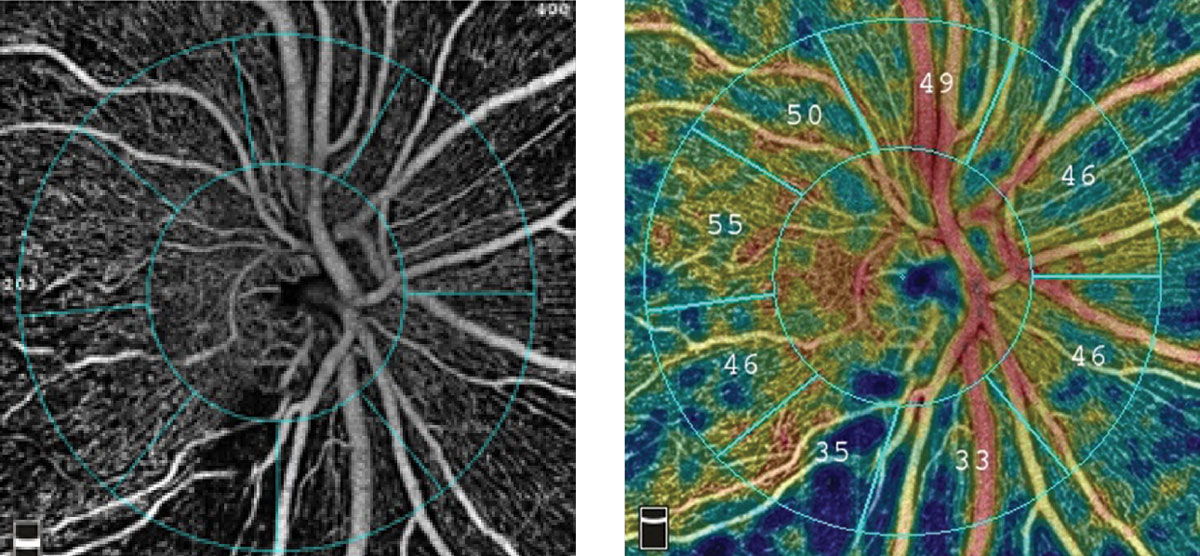A recent study investigated the effect of latanoprostene bunod 0.024% (Vyzulta, Bausch + Lomb) in newly diagnosed open-angle glaucoma patients, finding that not only did the treatment reduce intraocular pressure (IOP) by nearly a third on average, but it also led to increased vessel density. “Therefore,” the authors of the study wrote in their recent Journal of Glaucoma paper, the importance of Vyzulta in the treatment of glaucoma is likely to be that “it increases macular microcirculation, possibly via nitric oxide, independent of its IOP-reducing effect.”
 |
| A cohort of 66 patients with newly diagnosed open-angle glaucoma had an average IOP reduction of around 30% after one month of treatment with latanoprostene bunod 0.024% drops. Even more interestingly, patients also showed improved vessel density in different quadrants in all OCT-A slabs. Photo: Julie Rodman, OD. Click image to enlarge. |
Enrolled in the single-center, prospective study were 66 patients diagnosed with open-angle glaucoma, divided into two subgroups: 34 with primary open-angle glaucoma (POAG) and 32 with pseudoexfoliative glaucoma (PXG). These two groups were compared with 32 healthy controls. IOP was measured using Goldmann tonometry, and OCT-A imaging was performed at baseline and one month following Vyzulta administration to evaluate changes in vessel density within multiple retinal layers.
Following one month of daily treatment, patients demonstrated a mean IOP reduction of 7.7mm Hg, corresponding to a decrease of approximately 30.8%. This reduction was slightly greater among PXG patients (31.8%) than those with POAG (29.9%). Moreover, there was a significant improvement in macular vessel density in all OCT-A slabs. In particular, the vessel density in the superficial slab's superior and nasal quadrants showed remarkable improvement compared to baseline values.
The researchers pointed out in their paper that “the amount of IOP reduction (mm Hg or %) was not correlated with vessel density at baseline (pretreatment) or during treatment (except in the superior quadrant of the deep capillary plexus vessel density).” While the data from this study cannot clarify the mechanism behind these beneficial vascular effects of Vyzulta, the authors propose several hypotheses.
“One of the two active molecules, nitric oxide, may have caused vasodilation in retinal vessels and increased vessel density independent of the magnitude of IOP reduction,” they wrote. “Another idea is that the reduction in IOP may have reduced stress on the retinal vasculature and improved blood circulation.”
The power of this study is limited by its small sample size; additionally, it only included patients with early to moderate glaucoma at the time of diagnosis, so research on patients with more severe disease is still needed. The authors also disclosed in their paper that “it is not clear whether statistically significant changes are clinically relevant.”
In conclusion, they stated that a large population-based prospective randomized trial would help further the effects of non-nitric oxide-containing PGAs on retinal vasculature in open-angle glaucoma.
| Click here for journal source. |
Özer Ö, Baysal Z, Yıldırım Biçer G, Doğan L. The effect of latanoprostene bunod 0.024% on optical coherence tomography angiography in newly diagnosed open angle glaucoma. J Glaucoma. November 27, 2024. [Epub ahead of print]. |



